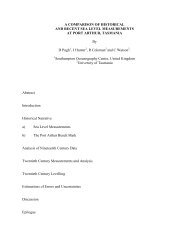Annual report 2005-06.indd - Antarctic Climate and Ecosystems ...
Annual report 2005-06.indd - Antarctic Climate and Ecosystems ...
Annual report 2005-06.indd - Antarctic Climate and Ecosystems ...
You also want an ePaper? Increase the reach of your titles
YUMPU automatically turns print PDFs into web optimized ePapers that Google loves.
ocean control of carbon dioxideseparate particles by sinking rates – a keycontrol on carbon export (in collaborationwith American researchers in the ‘VERTIGO’Vertical Flux in the Global Ocean program);iii) deployment of the PULSE mooring– the first surface-mooring in the openSouthern Ocean based on an innovativeshock-dampening design, with the goal ofobtaining continuous observations of mixedlayer depth, light levels, <strong>and</strong> in later yearsphytoplankton <strong>and</strong> nutrient concentrationsto address the role of surface dynamicsin the control of ecosystem structure <strong>and</strong>carbon export; iv) development of analyticalmethods for particulate carbonate <strong>and</strong>particulate silicate concentrations; <strong>and</strong> v)critical reviews of sediment trap techniques(Buesseler et al., Journal of Marine Research,in review) <strong>and</strong> the application of 234 Thdisequilibria to the estimation of carbonexport (Buesseler et al., Marine Chemistry,2006).CO2-03: Iron biogeochemistryProject leaderAndrew Bowie, ACE CRCProject staffS Bray, T Remenyi, L Robertson, ACE; E Butler,CMAR; P Boyd, NIWAKey achievements in <strong>2005</strong>-06• Demonstration that elevated phytoplanktonbiomass over the Kerguelen plateau in theIndian sector of the Southern Ocean as seenin satellite remote sensing images is fuelledby iron inputs from deep waters, <strong>and</strong> thusthis region represents an area of naturalpersistent iron fertilisation that can informdebate about the role of iron in the control ofatmospheric CO 2. This work was undertakenin collaboration with the Carbon ExportProcesses project <strong>and</strong> European researchersas part of the French KEOPS program (Blainet al., Nature, in review).• Demonstration that dissolved ironconcentrations are low in surface watersalong the WOCE/Clivar transect fromTasmania to Australia with early springdepletion in polar waters, but evidenceof continued inputs into summer in sub-<strong>Antarctic</strong> waters from sources to the north(Sedwick et al., Deep-Sea Research, inreview).• Advances in observational strategies for themeasurement of biogeochemical properties,including i) international intercomparison ofiron analytical techniques (Bowie et al., 2006)<strong>and</strong> ii) trace-metal clean size-fractionationfiltration techniques.Project AimWe are evaluating the importance of iron <strong>and</strong>other trace micronutrient elements in drivingSouthern Ocean biogeochemical cycles. Theresearch team will map the distribution ofdissolved iron in waters south of Australia,fingerprint supply <strong>and</strong> removal mechanisms,<strong>and</strong> quantify trace element limitation ofphytoplankton growth <strong>and</strong> community structurein sub-<strong>Antarctic</strong> ecosystems. This project willfeed vital information on the prevalence <strong>and</strong>flux of trace elements into biogeochemical <strong>and</strong>ecosystem models of the region, thus allowing aprediction of the role of Southern Ocean biologyin past <strong>and</strong> future regulation of atmospheric CO 2through ecosystem control of carbon transferto the deep ocean. The research will assessthe risk <strong>and</strong> efficacy of proposals to increasecarbon sequestration through intentional ironfertilisation of the Southern Ocean.<strong>Antarctic</strong> <strong>Climate</strong> & <strong>Ecosystems</strong> CRC - <strong>Annual</strong> Report <strong>2005</strong>-06 31








